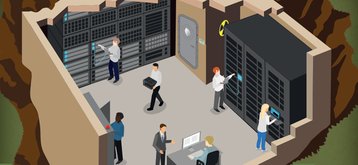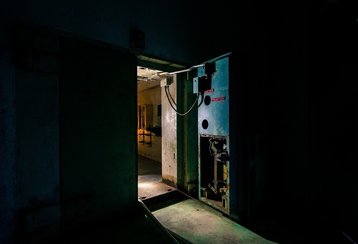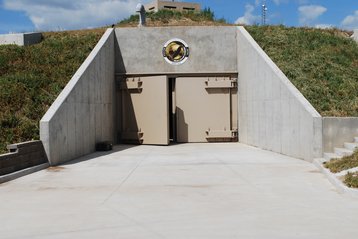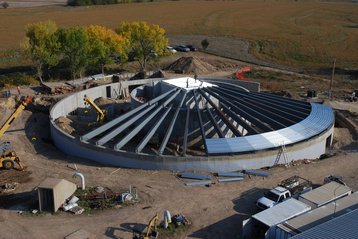During the height of the Cold War, with the Doomsday Clock minutes from midnight, the United States government drew up plans for all out war with the Soviet Union. Secretly investing billions, it created huge underground structures - some for launching devastating strikes, and others for surviving incoming nuclear attacks.
Remains of that vast infrastructure can be found in Texas, where huge missile silos lie hundreds of feet beneath unassuming farmland. Elsewhere, in Florida, the backbone of a post-apocalyptic communications system sits behind 42-inch walls, dug into the side of a hill.
After the threat of nuclear disaster receded and the Soviet Union collapsed, these sites have lain dormant for decades. Now, they could find new life as data centers - because of fresh security concerns.
“I believe that we’re getting into a time in the world where things are becoming less and less secure,” Mark Oxley, CTO and founder of Florida-based Data Shelter, told DCD. “You need to build to the highest level that you can really afford to.”
A nuclear bunker might be considered overkill for some people, but not for Oxley. His data center is located just 10 miles away from the coast of Florida, and yet he can say: “if there’s a hurricane coming, I really wouldn’t worry.”
Built to last
This confidence in surviving nature’s worst is based on the history of the site, which was originally part of the North American Aerospace Defense Command (NORAD). It was built in 1964 by AT&T and the Department of Defense (DoD) as an independent, self-powering installation for Autovon - a long-distance military telephone system designed to withstand enemy attacks.
Autovon emerged from the Army’s Switch Communications Automated Network (SCAN) system, and used a complex non-hierarchical routing structure to survive the destruction of multiple nodes - something that eventually helped inspire the Internet.
Even though Autovon could withstand the loss of some nodes, its facilities were built to remain operational in almost all eventualities. “I have 3,000 pound blast doors,” Oxley said. “The external wall is 42 inches thick, the internal walls are 12 inches thick, poured concrete, with metal rebars in them.”
In the 1990s, Autovon was replaced with the Defense Switched Network, leaving a hardened shell which Oxley is turning into an extremely well-protected data center. His “sole vision of the last ten years,” he hopes to open the facility in late 2018.
“I wanted to fix all the problems that I’ve seen in the data center industry,” Oxley explained. “Fifteen or so years ago, it was acceptable for eBay to go offline for three hours every weekend. That’s not acceptable today, and I don’t think data centers have actually caught up to that.”
Oxley became fascinated with the concept of downtime and how to minimize outages: “I realized there are probably three areas of critical impact to a data center - equipment failure, natural disaster and human error.”
For the last three years, Data Shelter has tried to design its site to mitigate these areas as best they can - “we’ve looked at how to solve these problems using intelligent design, hardened infrastructure and process education,” Oxley said, with the facility an Uptime Tier IV Design Certified site.
The threats Oxley hopes to protect against include hurricanes, tornadoes, and even chemical spills on the highway, he said, and the data center “can withstand a pretty large amount of radiation, including electromagnetic pulses (EMPs).”
The sheer strength of the physical walls is almost incidental. Oxley admitted to DCD: “I wasn’t necessarily looking for a former nuclear bomb shelter. I’m not building this to withstand a nuclear blast, but I am looking to really mitigate everything surrounding it.”
Oxley may not have been searching for a nuclear bomb shelter, but for others such shelters have formed the basis of their entire business model. Larry Hall, owner of the Survival Condo Project, has specifically sought out Atlas missile silos to engineer modern-day fallout bunkers.
Hall’s work building luxury doomsday condos for the super rich has seen widespread media coverage and - we are told - consumer interest. But he is also building data centers, Hall revealed to DCD in his first ever interview about his company’s plans.
“I used to own an Internet company in Florida. I built a couple of different data centers, just Internet service and colocation facilities, but nothing massive. After 9/11 I thought there would be a need for nuclear-hardened data centers,” he said.
“I was going to sell data centers, so companies can buy one or more floors and put their equipment there and it would be protected from aircraft flying into the facility, or bombs going off, or EMPs.”
With previous clients including defense contractors Northrop Grumman and Harris Corporation, Hall says his proposal got a great response at first, but then the dotcom crash happened: “You could buy data centers for 20 cents on the dollar. They opted for buying multiple locations.“
Having a blast
Instead, he turned to selling luxury bunkers: condos with all the features of a high-end living space - including indoor pools and spas, cinemas and gyms - that happen to be in F-series Atlas missile silos.
The last of the Atlas ICBM sites to be built, the F-series are made from concrete mixed with epoxy resin, along with roughly 600 tons of steel rebar, creating some of the strongest structures ever built by man.
Now, Hall believes the market is once again ready for him to try and build data centers: “Eight years later, it’s coming back.”
Hall has designed data center projects that could turn silos into facilities which would protect personnel, data and hard physical assets. Most are covered by nondisclosure agreements, but one company based in Texas “is actively looking for me to convert one of the silos into a data center that is 70 percent for data, and 30 percent for key personnel.”
Hall claims that “one big national company” is “secretly going out there trying to get commitments for occupancy,” and has asked “for a price to convert five silos into these data centers” that again saves space for personnel.
Such sites would provide a perk for senior staff, he said: “What they’re doing, in my mind, is finding a way to use their corporate needs for security to incorporate, as a fringe benefit, protection for executive-level families.”
In the last eight years, companies have started reassessing their vulnerabilities in the light of emerging threats: “Because of terrorism, the North Korean situation and floods, they’re coming up with new requirements.
“One of the scenarios doesn’t have Kim Jong Un dropping a nuclear bomb. He sets off an EMP over Kansas, in the middle of the US, and watches the Stone Age return.”
Hall thinks his silos offer a unique cost advantage, since the military did the heavy lifting back in 1960 when the US government spent about $15m (~$125m in 2017) on each site.
“The outfit in Texas told me that when they build a new Tier IV data center, they’re looking north of $12-14,000 per square foot for their facilities. I can bring them into a nuclear hardened facility, which is beyond the physical protection that they’re paying that price for - for $750 a square foot or less.”
But over in Florida, Oxley isn’t so sure that the cost benefit is fully worth it.
When asked about the challenges of designing a data center in a fixed, hardened structure, he let out an audible sigh: “Well, the current facility actually posed a lot of challenges because of the footprint of different rooms.”
“I can’t just blow out walls,” he said. “I can’t move a wall six inches because I don’t have enough room. So there was a huge challenge in finding the right HVAC equipment and power equipment that could fit in certain rooms to operate the facility as it currently stands.”
That’s why any future Data Shelter facilities could be entirely new sites. “If this concept really is what I think it will be to the industry, then the next one we would do will be a ground up build.
“I would build to the same or similar design standards as the current facility; underground, in a heavy-duty concrete bunker. But I wouldn’t look to retrofit. I think we spent a lot more time and a lot more energy retrofitting than we would have, had we built from the ground up. And that’s a lesson learned.”
Hall also hopes to build new data centers, and is in talks with one “customer that already owns large tracts of land in remote areas that don’t have a missile silo on them, and they want me to build a bunker for them.”
There’s a world going on underground
To meet this need, the company has developed what it calls ‘the next generation of bunkers:’ “We’re looking at building some of these in Texas, and we’re pricing another one out for a client in Idaho. They are essentially underground domes connected with tunnels.”
There are only 72 Atlas F bunkers, so “you need something more scalable, and I think the underground monolithic dome is a perfect solution,” he said.
Oxley thinks facilities like those from Data Shelter and Survival Condo will create a whole new segment of the data center market, built to last: “A lot of the issues that are occurring are because people are building these warehouse-style facilities that are thrown up very quickly, inexpensively, with very little design thought.
“They’re aging and having failures. The processes and the education level in running the facilities are not up to par. I believe that’s where the industry needs to change.”
He thinks customers “should demand more - you have to look at the data center lifespan as a whole, and say: over the lifespan, how many possible outages could we have and does it make sense financially to not build to the best design you can? I don’t believe that you should settle for anything less.”
In Texas, Hall sees this as a dramatic reversal of his life’s work, essentially forging swords into plowshares.
“I used to work for the government and saw what they’re doing on continuity of government structures. In data centers, I worked for some of the big military-industrial complex companies and it was a very challenging job,” he said.
“But there’s a big difference between building weapons of mass destruction and converting those same facilities into life-saving facilities.”
This article appeared in the December/January issue of DCD Magazine. Subscribe to the digital and print editions here:




